

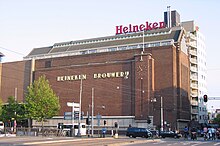
The Ferdinand Bolstraat is a street in Amsterdam, named after the artist Ferdinand Bol in 1872.



The Ferdinand Bolstraat is a street in Amsterdam, named after the artist Ferdinand Bol in 1872.
The Ferdinand Bolstraat has traditionally been, and continues to be, primarily a shopping street. It is a major artery of the neighbourhood De Pijp. The street is an extension of the Vijzelstraat which runs south from Muntplein square in the centre of Amsterdam. The street runs more or less north–south from the park and traffic circle Weteringplantsoen to the Amstelkanaal canal and Churchilllaan boulevard. From there, the street continues southward as the Scheldestraat towards Europaplein square, where the RAI convention centre is located. The Ferdinand Bolstraat intersects with Albert Cuypstraat, where the popular daily street market Albert Cuyp Market is located. It also intersects the Ceintuurbaan, a traffic artery running roughly west–east from Boerenwetering canal to the Amstel river.
Well-known buildings include the original Heineken brewery (now home to the Heineken Experience) at the northern end of the street and the five-star, 23-floor Okura Hotel, a 78 metres tall building which, when completed in 1971, was the second-tallest in the city of Amsterdam.
De Pijp metro station, a station of the North/South Line of the Amsterdam Metro, has an entrance on Ferdinand Bolstraat. Because the street is quite narrow, the station's platforms were not built adjacent to one another but one below the other. Tram line 24 runs through the Ferdinand Bolstraat.
In 1875, a bridge replaced the ferry over the Singelgracht canal, connecting the Ferdinand Bolstraat to the city centre. After part of the municipality of Nieuwer-Amstel was annexed by Amsterdam in 1896, the street was gradually extended further south, towards the Amstelkanaal canal.
In the 1960s, the city government planned to demolish the street and replace it with a broad boulevard. However, these plans were abandoned after protests from local activists, such as the politician Jan Schaefer. After the RAI convention centre moved from its original location on Ferdinand Bolstraat to the current complex on Europaplein in the 1960s, and the RAI building was demolished in 1976, there were plans to replace it with an opera house, as Berlage had intended. However, these plans were also abandoned after protests from local residents, and the Stopera (a combined opera house and city hall) was built instead at a different location in Amsterdam.
In 2008 the council of the borough of Oud-Zuid decided that the southern section of Ferdinand Bolstraat, between Albert Cuypstraat and Ceintuurbaan, will remain a car-free pedestrian area even after completion of the metro station (expected in 2017). No decision has been made yet on the northern section of the street.
In 2017 a 140-metre section of the tramline which serves the street, between Saenredamstraat and Quellijnstraat, was made single-track.
FEBO, a well-known chain of fast-food restaurants in the Netherlands, was named after the Ferdinand Bolstraat. The chain started in 1941 as a bakery called Maison FEBO. However, this bakery was not actually located on Ferdinand Bolstraat, although it was originally intended to be located there.

GVB is the municipal public transport operator for Amsterdam, the capital of the Netherlands, operating metro, tram, bus and ferry services in the metropolitan area of Amsterdam.

Amsterdam Zuid is a railway station situated in the borough of Amsterdam-Zuid in Amsterdam, Netherlands. For a number of years, it was named Amsterdam Zuid WTC, in reference to the neighbouring World Trade Center Amsterdam. During 2006, in conjunction with the rapid development of the area surrounding the station, the station was enlarged and the reference to the WTC was formally dropped from the name.

Oud-Zuid is the name of a neighbourhood and of a (larger) former borough (stadsdeel) of Amsterdam.

The Albert Cuyp Market is a street market in Amsterdam, The Netherlands, on the Albert Cuypstraat between Ferdinand Bolstraat and Van Woustraat, in the De Pijp area of the Oud-Zuid district of the city. The street and market are named for Albert Cuyp, a painter from the 17th century.

The Amsterdam Tram is a tram network in Amsterdam, Netherlands. It dates back to 1875 and since 1943 has been operated by municipal public transport operator Gemeentelijk Vervoerbedrijf (GVB), which also runs the Amsterdam Metro and the city bus and ferry services. Amsterdam has the largest tram network in the Netherlands and one of the largest in Europe.
The Dutch city of Amsterdam has had many planned expansions over the past two centuries.
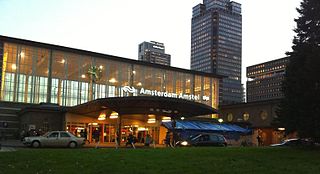
Amsterdam Amstel is a railway station in Amsterdam, Netherlands. The station opened in 1939. It is located to the southeast of Amsterdam Centraal in the borough of Amsterdam-Oost, near the Amstel river. Amsterdam Amstel is used daily by 50,000 train and metro passengers. Rail services at the station are provided by NS, the principal railway operator in the Netherlands. Metro, tram and city bus services are provided by municipal operator GVB. Regional buses are operated by Transdev and Keolis.
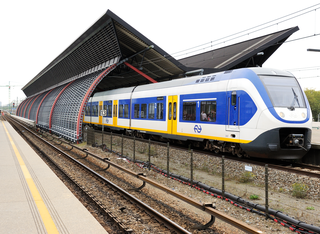
Amsterdam RAI is a railway station situated in southern Amsterdam, Netherlands. It is located between the two directions of the A10 Amsterdam ring road. It is also a metro station at which GVB runs two lines. The station takes its name from the nearby RAI Amsterdam Convention Centre.

The Marie Heinekenplein is a square in Amsterdam, Netherlands, popularly known as the Heinekenplein. The circle-shaped square is used for various events, such as a book market and an open-air cinema.

Amsterdam-Zuid is a borough (stadsdeel) of Amsterdam, Netherlands. The borough was formed in 2010 as a merger of the former boroughs Oud-Zuid and Zuideramstel. The borough has almost 138,000 inhabitants (2013). With 8,500 homes per square kilometer, it is one of the most densely populated boroughs of Amsterdam. It has the highest income per household of all boroughs in Amsterdam.
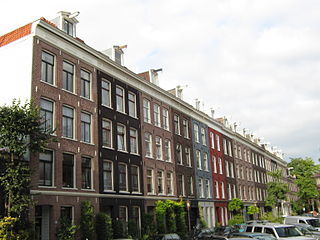
De Pijp is a neighbourhood of Amsterdam, Netherlands. It is located directly south of Amsterdam's city centre and it is part of the borough Amsterdam-Zuid, in a part of the city known as the Old South. It is served by De Pijp metro station. Most streets in De Pijp are named after Dutch painters, like Jan Steen, Frans Hals, Ruysdael and Vincent van Gogh. The three districts composing the area are Oude Pijp, Nieuwe Pijp and Diamantbuurt.
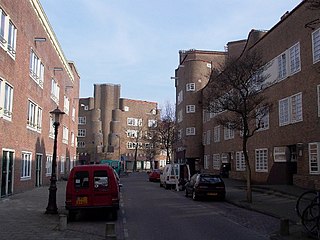
Nieuwe Pijp is a neighbourhood in Amsterdam, Netherlands. It is part of the borough of Amsterdam-Zuid. The Nieuwe Pijp is bordered by Ceintuurbaan and Sarphatipark in the north, Van Woustraat in the east, Amstel Canal in the south and Boerenwetering canal in the west. Along with the Oude Pijp, situated north of the Nieuwe Pijp, it is often simply referred to as De Pijp.

Oude Pijp, also known as Noord-Pijp is a neighbourhood of Amsterdam, Netherlands located in an urbanised part of the Zuid borough. It had a population of 14,102 in 2011 and an area of 68 hectares. Together with Nieuwe Pijp, Oude Pijp forms De Pijp.

Rivierenbuurt is a neighbourhood of Amsterdam, Netherlands. The neighbourhood is situated in the eastern part of the borough of Amsterdam-Zuid, bordered by the river Amstel to the east, the Boerenwetering canal in the west, the Amstelkanaal in the north and the A10 motorway in the south. In 2013, the Rivierenbuurt had approximately 28,400 residents.

Amstelveenseweg is an Amsterdam Metro station in the south of Amsterdam, Netherlands. The station opened in 1997 and is served by line 50 and 51.

Hotel Okura Amsterdam is a hotel in Amsterdam that is part of the Japanese chain Okura Hotels & Resorts. The 23-floor building has a height of 78 metres, and was designed by Dutch architects Bernard Bijvoet and Gerard Holt and Japanese architects Yoshiro Taniguchi and Yozo Shibata. The hotel is located on the Ferdinand Bolstraat and the Jozef Israelskade near the Barbiersbrug over the Amstel Canal, and was opened in September 1971 by Prince Claus. Upon its completion/opening, Hotel Okura Amsterdam was the second tallest building in Amsterdam; only Tower Overhoeks in Amsterdam-Noord was even higher. The hotel was the first European hotel of the Okura hotel chain. It is a member of The Leading Hotels of the World.

De Pijp metro station is a station on the Route 52 of the Amsterdam Metro in Amsterdam, Netherlands. It was opened on 22 July 2018. Prior to March 2012, this station was known as the Ceintuurbaan. De Pijp is an underground station situated in the Oude Pijp neighbourhood of the borough of Amsterdam-Zuid. The station is expected to handle around 18,000 passengers and arrivals per day.

Europaplein metro station is a station on the Route 52 of the Amsterdam Metro in Amsterdam, Netherlands. It was opened on 22 July 2018. Europaplein is an underground station situated in the Zuidas neighbourhood of Amsterdam-Zuid. The station is expected to handle around 20,000 passengers and arrivals per day.

Rokin metro station is an Amsterdam Metro station on Line 52, the fifth and newest metro line in Amsterdam which connects the Amsterdam-Noord (north) borough to the Amsterdam-Zuid (south) via Amsterdam Centraal. It began service in July 2018 and is under the Rokin canal in Amsterdam, Netherlands.